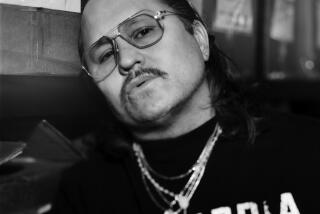The chic crossroad of East, West
WASHINGTON — Two ancient terra-cotta warriors of Xian, weighing more than 400 pounds each, stand guard at the entrance to “The New China Chic” exhibit, as if ready to protect China’s precious textiles along the Silk Road.
In fact, beyond them lies the modern equivalent, a collection of exquisitely detailed and geometric gowns, jackets and jewels by the most prominent designers of Chinese heritage today. There’s the elegant wrap skirt by Yeohlee that evokes the texture and shape of a peasant worker’s sarong. A white linen trench coat from Vivienne Tam with the off-center closure and mandarin collar of a classic cheongsam. Then there are the retro styles of Anna Sui, which can feel as much like ‘60s London as modern Shanghai.
The show is part of the Kennedy Center’s Festival of China, which kicked off Saturday night with an explosion of fireworks along the Potomac River. The monthlong event, which organizers describe as the largest celebration of Chinese culture by a U.S. arts institution, will present 900 performers in 53 symphonies, ballets, operas and puppet shows. Like the rest of the festival, the fashion on display makes the point that as ancient as the culture is, it is also emphatically modern.
“These clothes are not part of the Chinese folklore history to which we might instinctively limit them,” said Adrien Gardere, who designed the exhibit. “It’s not only on the United Nations Security Council that we are on equal ground. The world of fashion is assimilated. We’re all on the same playground.”
Gardere transformed what is usually the Kennedy Center’s KC Jazz Club into an intimate parlor with a sense of history. The ancient warriors outside are linked to a contemporary Vera Wang wedding dress inside by red cords, hung vertically and interspersed with red-roped Chinese knots.
“The Kennedy Center has an impressive, solemn dimension,” he said. “The idea was to make a thread between the building and the exhibit, between old China and Chinese designers. I started weaving.”
Some of the first representatives of the new are the evening gowns of Zang Toi, decorated with beading and embroidery that evoke the acute attention to detail of Chinese handicraft. The youngest son of seven children of Chinese shopkeepers in Malaysia -- both sets of grandparents fled China during World War II -- Toi traces his use of vibrant color to watching the glamorous stars of old Chinese movies in their gowns of lucky red, emperor yellow and jade green.
From that somewhat traditional beginning, the exhibit wends its way to what might be called the “bridge” designers such as Amy Chan, whose purses are made with fabrics fused with surprising textures, such as slithery mesh metallic or tiny plastic tiles. Born in Hong Kong, Chan moved to New York with her family when she was 11, and a mixture of influences from Chinese symbols to ikat patterns is apparent in her work.
At the far end of the exhibit, which runs through Oct. 16, are works by Wang, who shows three winter pieces, in anti-bridal shades of chocolate brown, bottle green and navy blue, in addition to the wedding dress. There are also a fire engine red trench coat from Derek Lam, who designed clothes for President Bush’s daughter Barbara to wear at his second inaugural, and Peter Som’s high-collared, almost military wool jackets.
From there, the exhibit swings back to a more contemporary take on Asian design, almost a reappropriation of shape and texture by designers like Yeohlee, who coined the term “urban nomad” to describe a generation of clients who travel in style and who won their appreciation with styles like her “Manchurian wrap coat.”
Jewelry rounds out the exhibit, including cutting-edge platinum pieces by Christian Tse. Perhaps no designer better captures the assimilated global fashion sense -- one that’s grounded in Asian techniques and shapes, updated with innovative metalsmithing and schooled in runway economics.
Tse is a third-generation jeweler whose father still runs a jewelry shop in Los Angeles’ Chinatown. His father, Tong Tse, left China for Cambodia and then, when war broke out and his youngest son, Christian, was 4, emigrated with his family to Detroit. When Christian was 11, his father bought him a bench and taught him the goldsmith’s trade. The “grunt work” that Tse grumbled about as a child -- the lessons in drawing wire, melting metal and even creating tools -- now inspire his fluid mesh designs, which have been called lingerie for the neck.
But it was America -- particularly living near Detroit and hoping for a career as an automotive designer -- that gave him the ambition to reach a mass market. He explored designs that would wow a trade show audience, and eventually he drew the eye of those buyers, and of Hollywood -- Kim Cattrall wore his 18-karat gold lariat necklace on an episode of “Sex and the City,” and more recently he designed a ring for the “Pink Panther” movie due out in February.
“I consider myself more American than Chinese,” said Tse, from his home in Pasadena. “But as you get older, you go back to your heritage.”
More to Read
The biggest entertainment stories
Get our big stories about Hollywood, film, television, music, arts, culture and more right in your inbox as soon as they publish.
You may occasionally receive promotional content from the Los Angeles Times.










